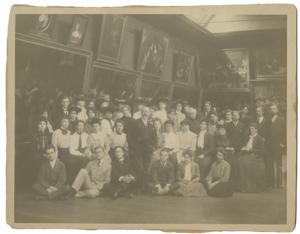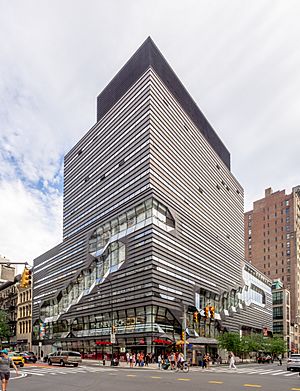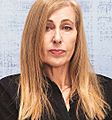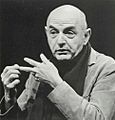Parsons School of Design facts for kids
|
Former names
|
|
|---|---|
| Type | Private Art and Design School |
| Established | 1896 |
|
Parent institution
|
The New School |
| Accreditation | AICAD NASAD NYSED MSCHE NAAB |
| Dean | Yvonne Watson |
|
Academic staff
|
1,400 |
| Students | 5,755 |
| Undergraduates | 4,604 |
| Postgraduates | 1,151 |
| Location |
,
40°44′07″N 73°59′39″W / 40.73528°N 73.99417°W |
| Campus | Urban |
| Colors | White, Black, Parsons Red |
| Affiliations | Cooper Hewitt, Smithsonian Design Museum |
| Mascot | Gnarls the Narwhal |
 |
|
The Parsons School of Design is a private art and design college located in New York City. It's part of The New School university. Founded in 1896, Parsons is one of the oldest and most famous art and design schools in New York.
Parsons was a pioneer, being the first school to offer programs in fashion design, interior design, advertising, and graphic design. It was also the first American school to open a branch campus abroad, called the Paris Ateliers, in 1921. In 1970, Parsons joined The New School, becoming the first private art and design school to team up with a private national research university. The school has five main departments and offers many different art and design programs. Students can also take classes and even major in other subjects at The New School.
Contents
History of Parsons School of Design
How Parsons Started (19th Century)

Parsons began in 1896 in Manhattan as the Chase School. It was started by William Merritt Chase, a famous American painter. He and a small group of artists left another art school because they wanted a more modern and creative way of teaching. Early students included well-known artists like Marsden Hartley and Edward Hopper.
However, Chase was a great artist but not a great business manager. So, in 1898, the school got new leaders and was renamed the New York School of Art.
Growing and Changing (20th Century)
In 1904, Frank Alvah Parsons joined the school as a professor. He believed that art and design were becoming very important for industries. His ideas led to many "firsts" for the school. He started the first programs ever in fashion design (originally called costume design) in 1904. He also created programs for interior design (1906) and graphic design (1910).
In 1909, the school changed its name again to the New York School of Fine and Applied Art. This new name showed that it now offered both art and design classes. Frank Alvah Parsons became the main director of the school in 1911. He famously said in 1920 that "Art is not for the few... Industry is the nation's life, art is the quality of beauty in expression, and industrial art is the cornerstone of our national art."
In 1921, Frank Alvah Parsons and a former student, William M. Odom, opened the school's branch in Paris, France, called the Paris Ateliers.
After Frank Alvah Parsons passed away in 1930, William M. Odom took over as director. To honor Parsons and his important ideas, the school was renamed the Parsons School of Design in 1941.
By the mid-1960s, Parsons was known as a top place to train for the fashion industry. In 1970, Parsons joined The New School for Social Research, which helped it offer more degree programs and research opportunities. In the same year, Parsons was the first in the United States to give university degrees in fashion design, interior design, and lighting design.
Parsons Today (21st Century)
In 2005, the main university was renamed The New School. Because of this, Parsons was briefly called Parsons The New School for Design.
In 2015, the school went back to its original name, Parsons School of Design. Around this time, the school also got a new look for its logo and branding.
Parsons continues to be a leader in design education. In 2019, Parsons worked with IBM to create a special course on quantum computing for design. This project even won an award! Also in 2019, students from Parsons' Data Visualization program worked with the Metropolitan Museum of Art. They used museum data to create cool visual presentations.
In 2020, Parsons students teamed up with the United Nations. They worked on projects to help promote the UN's "Decade of Action" campaign, focusing on solutions for climate change and gender equality.
In 2022, Parsons' communications design department celebrated 100 years. They even published a book about it! This department was one of the first to offer an undergraduate program in this field.
In 2023, Parsons started a new Ph.D. program with RMIT in Australia. This allows students to work with professors from both schools.
Campus Life at Parsons
Parsons School of Design is located in New York City. It has several buildings that are part of The New School campus.
The University Center
The University Center is a large, modern building that opened in 2013. It's a very important part of The New School. This 16-story building was designed to be very energy-efficient. It has special features like sensors that turn off lights when no one is around, and systems to recycle water. It even has a plant that helps create its own energy!
The University Center has many facilities for students. It includes a library, dorm rooms, lecture halls, an 800-seat auditorium, dining areas, computer labs, and many different workshops. You can find sewing rooms, a shoemaking studio, and drawing studios here. The building also displays art from The New School Art Collection.
The Sheila C. Johnson Design Center
This building, at 70 Fifth Avenue, is one of the largest Parsons buildings. It was built in 1914 and has a rich history. From 1914 to 1923, it was the national office for the National Association for the Advancement of Colored People (NAACP). Many other groups working for justice and civil rights also had offices here.
Thanks to a gift from Sheila Johnson, the building was renovated. It now has classrooms, common areas, and art galleries like the Anna-Maria and Stephen Kellen Gallery. It also houses the Parsons Making Center, where students can create. The ground floor has the New School Archives, which keeps drawings, photos, and other items from 20th-century design. In 2021, this building was recognized as a New York City landmark because of its important history in supporting civil rights.
Parsons East Building
The Parsons East building is located at 25 East 13th Street. This is where you'll find the School of Constructed Environments. This school includes departments like Architecture, Interior Design, Lighting Design, and Product Design. The building also has cool workshops like the Laser Lab, Metal Shop, and woodcutting shop. The Fine Arts department also has studios here.
Libraries at Parsons
Parsons students have access to several libraries:
- Albert and Vera List Academic Center & Library: This library focuses on humanities and social sciences.
- Performing Arts Library: Located in Arnhold Hall, this library is perfect for students interested in music, theater, and dance. It has sheet music, scripts, and many books on these topics.
- University Center Library: Found in the main University Center, this library focuses on art, design, and technology. It has many books, magazines, and other materials. All libraries offer reading rooms and collaboration spaces for students.
- Archives & Special Collections: Located in the University Center lobby, this facility holds rare historical materials. It has unique publications, old magazines, and records from important people and organizations. Some cool digital collections include fashion runway slides and fashion sketch collections.
Academics at Parsons
Programs Offered
Parsons offers over 30 different degree programs for both undergraduate (college) and graduate (post-college) students. These programs are organized into five main schools:
- School of Art and Design History and Theory
- School of Art, Media, and Technology
- School of Constructed Environments
- School of Design Strategies
- School of Fashion
Students at Parsons can also take classes at other parts of The New School, like the College of Performing Arts or the Liberal Arts college.
How to Get In (Admissions)
Parsons School of Design accepts about 52% of students who apply. While students can submit SAT or ACT scores, they are not required for undergraduate applications. Most students applying for undergraduate programs need to submit a portfolio of their past artwork. They also have to respond to a special creative task called a "Parsons Challenge."
Rankings
Parsons School of Design is highly respected around the world. In 2022, it was ranked as the top art and design school in the United States by the QS World University Rankings. This was the fifth year in a row it held this top spot! Globally, Parsons was ranked third in art and design in the same report. Forbes magazine also named Parsons as one of America's top design schools in 2021. The school is especially famous for its fashion design program, which is often ranked among the best in the world.
Global Connections and Partnerships
Parsons Paris
In 1921, Frank Alvah Parsons opened a branch school in Paris, France, called the Paris Ateliers. It was located in a historic part of Paris. Parsons believed that France was a great place for artistic inspiration. The school offered courses in architecture, interior design, stage design, and fashion design. Famous designers like Christian Dior and Elsa Schiaparelli even visited to critique student work.
In 1931, students at the Paris Ateliers, led by designer Jean-Michel Frank, created the famous Parsons table. The Paris school closed in 1939 because of World War II.
Parsons reopened its Paris program later and it became known as Parsons Paris. For a while, it partnered with another American college in Paris. In 2008, that partnership ended, and the Paris school that used the Parsons name became a separate school called Paris College of Art.
However, in 2013, The New School opened a *new* academic center called Parsons Paris in Paris. This new school is fully part of Parsons School of Design. It offers various bachelor's and master's degrees in design, fashion, and business, and all classes are taught in English.
International Partnerships
Parsons also works with other schools around the world that share its teaching ideas.
- The Altos de Chavón School of Design in the Dominican Republic has partnered with Parsons since 1983. Students there can complete a two-year program and then transfer to Parsons in New York to finish their degree.
- Parsons is also working with the Indian School of Design and Innovation in Mumbai, India, hoping to create student exchange programs.
- In 2014, Parsons started a pre-college program in China called Parsons Pre-College China Program.
Cooper Hewitt, Smithsonian Design Museum
Parsons has a special partnership with the Cooper Hewitt, Smithsonian Design Museum in New York. They offer a two-year master's program together in History of Design and Curatorial Studies. This allows students to study design history and learn how to curate (organize) museum exhibitions.
Notable People from Parsons
Famous Alumni
Parsons has educated many influential artists and designers. Some famous alumni include:
- Painters: Jasper Johns, Roy Lichtenstein, Edward Hopper, Norman Rockwell, Julie Umerle
- Sculptor: Alexander Calder
- Industrial Designer: Sara Little Turnbull
- Fashion Designers: Donna Karan, Marc Jacobs, Alexander Wang, Tom Ford, Anna Sui, Jason Wu, Isaac Mizrahi, Derek Lam, Heron Preston
- Interior Designers: Van Day Truex, Mario Buatta
- Graphic Designer: Paul Rand
- Photographer: Duane Michals
- Artist and Activist: Ai Weiwei
- Film Director: Joel Schumacher
- Illustrator: Peter de Sève
Some notable alumni from famous families include Bella Hadid, Nicky Hilton Rothschild, and Brooklyn Beckham.
- Notable Parsons School of Design alumni include:
-
Jasper Johns: painter, sculptor, and printmaker
-
Roy Lichtenstein: pop artist
-
Tom Ford: fashion designer
-
Anna Sui: fashion designer
-
Alexander Calder: sculptor
-
Marc Jacobs: fashion designer
-
Donna Karan: fashion designer
-
Jason Wu: fashion designer
-
Norman Rockwell: painter, author, and illustrator
Faculty (Teachers)
Parsons has many talented teachers, including 127 full-time and over 1,000 part-time faculty members. Many of them are successful artists and designers in New York City. The ratio of students to teachers is about 10 to 1. Some notable faculty members have included Frank Lloyd Wright, Piet Mondrian, and Tim Gunn. Many teachers have won major awards for their work.
Student Life at Parsons
Students
Parsons has over 5,000 students. About 80% are undergraduate students, and 20% are graduate students. A large number of students (about 35%) are international, coming from 116 different countries. Most international students come from Asia, followed by Europe. In 2020-2021, 80% of students received some kind of financial help from the school. The New School, which Parsons is part of, has over 100 student organizations that students can join.
Student Publications
Students at Parsons and The New School create several publications:
- The New School Free Press (NSFP) is a student-run newspaper that covers events around the university.
- re:D is a magazine for Parsons alumni and the wider Parsons community.
- Scapes is an annual journal from the School of Constructed Environments.
- The Journal of Design Strategies explores how design and management work together.
- The Parsons Journal for Information Mapping (PJIM) focuses on how information is visualized.
- BIAS: Journal of Dress Practice is a journal about fashion studies.
- The Fashion Studies Journal is a monthly academic journal for fashion research.
Student Broadcasting
Students also run several online radio stations and podcasts:
- WNSR (New School Radio) is an online radio station run by students, featuring news and opinions.
- NSCR (New School CoPa Radio) is an online radio station run by the College of Performing Arts, playing music from students, faculty, and alumni.
- New Histories is a podcast run by faculty that explores the university's history.
- Public Seminar is a podcast about democracy through the lens of design, social sciences, and arts.
- Unbound is a student-run podcast about philosophy.
See also
 In Spanish: Parsons The New School for Design para niños
In Spanish: Parsons The New School for Design para niños
- Education in New York City
- New York Foundation
- New York Intellectuals
- Parsons table
- Project Pericles





















